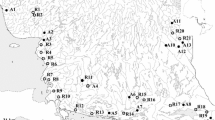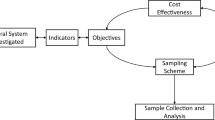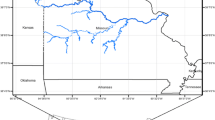Abstract
The objectives of this study were to: (1) analyzehistorical diazinon water column monitoring data frominconsistent monitoring programs in mainstem and tributary sitesin the Sacramento and Feather River watersheds from 1991 to 2001to assess possible spatial and temporal trends and (2) determinethe probability of measured diazinon concentrations by site orsimilar pooled sites exceeding various proposed effectsbenchmarks such as Water Quality Criteria and 10th centilesderived from species sensitivity distributions proposed as targetconcentrations for Total Maximum Daily Loads (TMDLs). An analysisof diazinon monitoring data from both fixed and rain eventsampling from the Sacramento/Feather River watersheds from 1991to 2001 showed that 90th centiles for 27 different mainstemand tributary sites ranged from 12 to 14,897 ng L-1. The 90th centiles were generally higher at tributary sites (as compared to mainstem sites) during rain event sampling prior to 1995. A comparison of rain event samples for similar sites sampled in 1994 and 2000 showed that 90th centiles were lower in seven of eight sites in 2000. A comparison of pooled mainstemsites between 1994 and 2000 for rain event data showed a lower90th centile value for 2000; 90th centiles were alsolower in 2000 at all pooled tributary sites and all sites whendata from a highly influential site was removed. For varioussite designations (all sites, pooled mainstem sites etc.) theprobability of exceeding the acute and chronic diazinon targetsdeveloped by California Department of Fish and Game decreasedfrom 1994 to 2000. These data clearly show progress in the 6 yrperiod in reducing environmental concentrations of diazinon.Probability of exceeding the 10th centile targets based onspecies sensitivity distributions for arthropods (the mostsensitive taxa to diazinon exposure) was similar and fairly lowbetween years; the highest percent probability of exceedance forany site designation was 20%.Results from a two-way ANOVA using individual measurementsfrom all sites sampled showed a significant decrease during rainevents between 1994 and 2000, although the decrease was notequivalent for all sites. Sources of uncertainty identified inthe analysis of rain event data from 1994 and 2000 wereinconsistent frequency of sampling during rain events for eachyear, unknown definition of rain events between the two years andnon-defined measurement point within the hydrograph of rainevents sampled in each year. Analysis of diazinon trends fromfixed sampling was limited due to lack of yearly data by site;therefore, only parametric analysis could be conducted. Based onparametric analysis of diazinon monitoring data from fixedsampling sites, the percent detected concentrations were greaterthan 20% for 12 tributary sites and 5 mainstem sites fromsamples collected during January-March. On the average over allsites and months, diazinon concentrations have decreased at fixedsampling sites in the Sacramento/Feather River watershed from1991 to 2001.
Similar content being viewed by others
References
Azimi-Gaylon, S., Menconi, M. and Grober, L. et al.: 2001, Diazinon and Chlorpyrifos Target Analysis: Workplan Product for Development of Diazinon and Chlorpyrifos Total Maximum Daily Loads in the Lower Sacramento River, Lower Feather River, Lower San Joaquin River and the Main Channels of the Sacramento-San Joaquin River Delta. Draft report prepared by California Environmental Protection Agency and the Regional Water Quality Control Board Central Valley Region, Sacramento, CA.
Dileanis, P. D., Domagaiski, J. L. and Bennett, K. P.: 2000, Occurrence and Transport of Diazinon in the Sacramento River and Its Tributaries during Three Winter Storms, January-February 2000. Report prepared for the California Department of Pesticide Regulation, Sacramento, CA.
Foe, C. and Sheipline, R.: 1993, Pesticides in Surface Water from Applications on Orchards and Alfalfa During the Winter and Spring of 1991-92. Report. Central Valley RegionalWater Quality Control Board, Sacramento, CA.
Giddings, J. M., Hall, L. W. Jr., and Solomon, K. R.: 2000, 'Ecological risks of diazinon for agricultural use in the Sacramento-San Joaquin River basins, California', Risk Anal. 20, 545-72.
Hall, L. W. Jr., Giddings, J. M. and Solomon, K. R.: 1999, 'An ecological risk assessment for the use of Irgarol 1051 as an algaecide for antifouling paint', Crit. Rev. Toxicol 29, 367-437.
Sacramento River Watershed Program Organophosphate Group: 2001, Water Quality Management Strategy for Diazinon in the Sacramento and Feather Rivers. Report. Sacramento River Watershed Program, Woodland, CA.
Solomon, K. R., Baker, D. B., Richards, P., Dixon, K. R., Klaine, S. J., LaPoint, T. M., Kendall, R. J., Giddings, J. M, Giesy, J. P., Hall, L. W. Jr., Weisskopf, C. and Williams, M.: 1996, 'Ecological risk assessment of atrazine in North American surface waters'. Environ. Toxicol. Chem. 15, 31-76.
Spurlock, F.: 2002, Analysis of Diazinon and Chlorpyrifos Surface Water Monitoring and Acute Toxicity Bioassay Data, 1991-2001. Report EH01-01. California Department of Pesticide Regulation, Sacramento, CA.
Author information
Authors and Affiliations
Corresponding author
Rights and permissions
About this article
Cite this article
Hall, L.W.J. Analysis of Diazinon Monitoring Data from the Sacramento and Feather River Watersheds: 1991–2001. Environ Monit Assess 86, 233–253 (2003). https://doi.org/10.1023/A:1024062613453
Issue Date:
DOI: https://doi.org/10.1023/A:1024062613453




